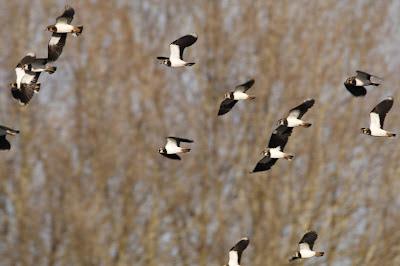BLUE TIT
After spending the morning at the Suffolk Owl Sanctuary the day continued with an afternoon trip to Lackford. Lackford can be a bit hit or miss, its a reserve with lots of common birds, lots of waterfowl, but it doesn't really attract anything unusual. That vein continued today, I saw lots of birds, but left feeling I could have had more. But I still enjoy going, because its a nice reserve, well laid out and because you do get good views of the birds.
On the entrance track to the reserve, REDWINGS and FIELDFARES were feeding along the hedgerows gobbling up the last meagre rations of berries left. The car park was fairly full, this reserve can be very popular, which just shows how important this reserve is for the area. The reserve centre had the usual birds feeding on the feeders outside, which included a MARSH TIT. No news had yet come back from the reserve about the birds that were there to see, so I wasn't holding my breath for anything out of the ordinary.
MARSH TIT on the visitor's centre feeders
The Western Lakes are the best for birds, attracting the vast majority of DUCKS.
The first lake on the way is the Sailing Lake, the largest of all the lakes and being winter there was no sailing, so the lake was absolutely full of DUCKS, with hundreds present. The majority were COOT, GADWALL and TUFTED DUCK, which were the main species to be found on all the lakes on the reserve. Found on the Sailing Lake and nowhere else in the reserve were POCHARDS with 60 - 70 present, mainly in the middle of the body of water.
POCHARDS on the sailing lake
The next lake was the Slough. Water levels were high here, and as a result the numbers of TEAL were quite low with around a hundred present. Again this species of duck was found only on this body of water on the reserve.Three hides overlook the Slough. In the middle hide photographers pack in because it overlooks a sheltered area of water which attracts KINGFISHERS. Five photographers were all waiting for a perched kingfisher maybe with a fish in its bill, to take a hundred of pictures all the same as the other four photographers in the hide. There were no KINGFISHERS here today, but a LITTLE GREBE was attracting attention for having caught a fish that was half the size of its body. On another lake a LITTLE GREBE had caught a smaller fish and was constantly being mobbed by a GULL, who couldn't dive for fish, to the extent it seemed the GULL just didn't like the GREBE and just wanted to pester him.
LITTLE GREBE
A flock of SISKINS were found in the lakeside alders identified by their 'sighing' call. A pair of MARSH TIT were calling to each other in Ash Carr, maybe establishing territories, or interaction between two potential mates. Annoyingly I forgot to bring along any bird seed, so I couldn't take any photos at the Stump.
A flock of LAPWING roosting on the Slough, would often fly in the air at the least persuasion.






No comments:
Post a Comment